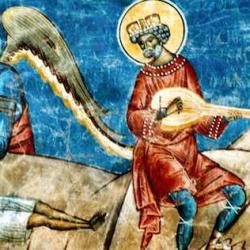A Footstool for His Feet, Psalm 110:1-7
INTRODUCTION
Forty days after Jesus rose from the dead, He ascended into heaven to take His place at the right hand of the Father (Acts 1:3). This past Thursday marked the fortieth day after Easter, and on this Sunday the church has commemorated this event.
THE TEXT
?The Lord said to my Lord, ?Sit at My right hand, till I make Your enemies Your footstool.?E The Lord shall send the rod of your strength out of Zion. Rule in the midst of your enemies . . . .?E(Psalm 110:1-7).
STRUCTURE
The Psalm is patterned as three sets of seven clauses. Verses 1-2 make up the first sequence, verses 3-4 the second, and verses 5-7 the third. This pattern alludes to the creation week, suggesting that the installation of the Lord at the right hand is the beginning of a new creation. The first and the last section begin with the name Yahweh and a reference to the ?right hand?Eof Yahweh (vv. 2, 5), and both include references to the power of king to conquer enemies (vv. 1-2, 5-6). The name ?Yahweh?Eis used three times (vv. 1, 2, 4).
LORD AND MY LORD
By translating two different words with the same word, English translations make the first verse of this Psalm more obscure than it is in the Hebrew. In Hebrew, the first ?Lord?Eis ?Yahweh,?Ethe covenant Name of God, while the second is adon or adonai , which is not a name but a title, one that is used as a title for human masters or even husbands (Genesis 18:12; 19:2; 40:1; Ruth 2:13; etc.). Adonai can also be used as a title for Yahweh, as in Exodus 34:23 (?the lord Yahweh, God of Israel?E and Deuteronomy 10:17 (?lord of lords,?EHeb. adone ha?adonim ). In many passages, a better translation for a phrase like ?Lord God?Ewould be ?Lord Yahweh?Eor ?Master Yahweh?E(e.g., Psalm 69:6).
In Psalm 110, David refers to someone as ?my lord,?Eand this someone is different from Yahweh. Who is David talking about? We know from the NT that David is talking about the Son of God, but who did David think he was talking about? There are two answers to this. First, David is certainly acting as a prophet here, looking forward to an ?Anointed One?Ewho is far greater than he himself is. The Psalm is directly Messianic and prophetic. Second, there is evidence in the OT of a Person who is distinct from Yahweh yet also somehow identical to Yahweh. This Person is sometimes identified as the ?angel of Yahweh?E(cf. Genesis 18; Zechariah 1:7-17). This is perhaps also identical to the ?Name?Eof Yahweh who dwells in the temple (1 Kings 8:16, 18, 20, etc.). Thus, David was conscious that, though he was the Lord?s anointed king over Israel, he was subordinate to the King enthroned above the cherubim.
VICTORY
Throughout the Psalm, the installation of David?s Lord at the right hand of Yahweh means victory. He is installed at the right hand until His enemies are made a footstool (v. 2), and he is to ?rule in the midst of Thine enemies?E(v. 2). From the right hand of Yahweh, he will ?shatter kings?Eand ?judge among the nations?Eand ?shatter the chief men over a broad country?E(vv. 5-6).
The NT teaches that this Psalm was fulfilled in Christ, and repeatedly refers to it in reference to Jesus?Eexaltation in His resurrection and ascension (Acts 2:34ff; 1 Corinthians 15:25; Hebrews 1:13; 10:13). If this is so, then Ascension Day is victory day. The ascension of Jesus means that He begins to rule in the midst of His enemies, begins to judge the nations, begins to shatter kings. An eschatology based on Psalm 110 is an eschatology of victory.
PRIEST AFTER THE ORDER OF MELCHIZEDEK
At the center of the Psalm is the promise that Yahweh would establish David?s lord not only as a king, ruling with a scepter (vv 1-2) but also as a priest after the order of Melchizedek (v. 4). Melchizedek was the priest of God and king of Salem, who came and met Abram with bread and wine after the latter had won a battle (Genesis 14). In response, Abram showed honor to Melchizedek by giving him a tithe.
In the NT, this part of the Psalm is taken as a prophecy of Jesus, who serves as both priest and king (Hebrews 7). But the writer of Hebrews goes further to say that the establishment of Jesus as a ?high priest?Eoverturns the priestly order of Aaron. How does this work? The priestly order of Aaron was based on physical descent; only men who were in the genealogy of Aaron could serve as priests. But Jesus was a member of the tribe of Judah, which was not a priestly tribe (Hebrews 7:14-16). Yet Jesus was designated as high priest. The writer sees this as a sign that the entire Old Covenant order has been shattered (Hebrews 7:17-23). A ?fleshly?Efirst covenant, which depended on physical descent, has been replaced by a ?spiritual?Esecond covenant, which depends on the resurrection power of Jesus (v 16). Thus, the Psalm predicts a new order of priesthood, and a new order of the world.
Catechism for Little Saints
When did Jesus ascend into heaven?
Jesus ascended forty days after He rose from the dead.
What does it mean for Jesus to sit at the ?right hand?Eof God?
It means that He rules the nations and judges them, and will be victorious over all His enemies.














